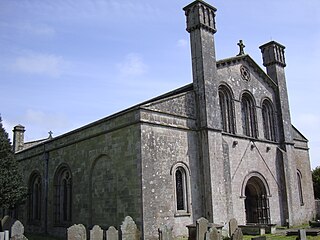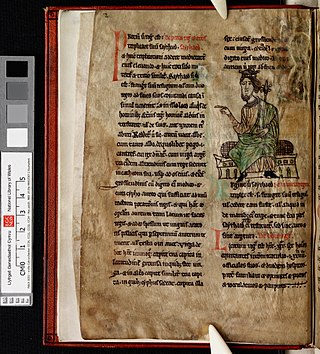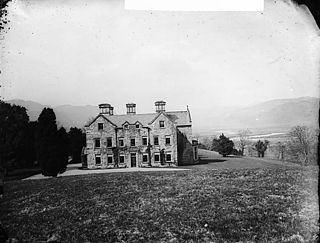Related Research Articles

The National Library of Wales, Aberystwyth, is the national legal deposit library of Wales and is one of the Welsh Government sponsored bodies. It is the biggest library in Wales, holding over 6.5 million books and periodicals, and the largest collections of archives, portraits, maps and photographic images in Wales. The Library is also home to the national collection of Welsh manuscripts, the National Screen and Sound Archive of Wales, and the most comprehensive collection of paintings and topographical prints in Wales. As the primary research library and archive in Wales and one of the largest research libraries in the United Kingdom, the National Library is a member of Research Libraries UK (RLUK) and the Consortium of European Research Libraries (CERL).
The Hengwrt Chaucer manuscript is an early-15th-century manuscript of the Canterbury Tales, held in the National Library of Wales, in Aberystwyth. It is an important source for Chaucer's text, and was possibly written by someone with access to an original authorial holograph, now lost.

The Welsh Triads are a group of related texts in medieval manuscripts which preserve fragments of Welsh folklore, mythology and traditional history in groups of three. The triad is a rhetorical form whereby objects are grouped together in threes, with a heading indicating the point of likeness; for example, "Three things not easily restrained, the flow of a torrent, the flight of an arrow, and the tongue of a fool."

The White Book of Rhydderch is one of the most notable and celebrated surviving manuscripts in Welsh. Mostly written in southwest Wales in the middle of the 14th century it is the earliest collection of Welsh prose texts, though it also contains some examples of early Welsh poetry. It is now part of the collection of the National Library of Wales, having been preserved in the library at Hengwrt, near Dolgellau, Gwynedd, of the 17th century antiquary Robert Vaughan, who inherited it from the calligrapher John Jones and passed it to his descendants. The collection later passed to the newly established National Library of Wales as the Peniarth or Hengwrt-Peniarth Manuscripts.

Cyfraith Hywel, also known as Welsh law, was the system of law practised in medieval Wales before its final conquest by England. Subsequently, the Welsh law's criminal codes were superseded by the Statute of Rhuddlan in AD 1284 and its civil codes by Henry VIII's series of Laws in Wales Acts between 1535 and 1542.

Various traditions are practiced on certain days of the year in Wales both currently and historically, including festivities originating in Welsh, Celtic, English and Christian cultures.
Brenhinoedd y Saeson is the medieval title of three Middle Welsh annalistic chronicles known from three 14th-century manuscripts recording events from 682 to the English conquest of Wales in 1282. The title Brenhinoedd y Saeson is found only in the rubric to the earlier of the two surviving manuscripts of version S: the other two texts are commonly known as Brut y Tywysogion, but this title is found only in manuscripts of the late 16th century and cannot be considered authentic.
Robert Powell Vaughan was an eminent Welsh antiquary and collector of manuscripts. His collection, later known as the Hengwrt–Peniarth Library from the houses in which it was successively preserved, formed the nucleus of the National Library of Wales, and is still in its care.

Brut y Brenhinedd is a collection of variant Middle Welsh versions of Geoffrey of Monmouth's Latin Historia Regum Britanniae. About 60 versions survive, with the earliest dating to the mid-13th century. Adaptations of Geoffrey's Historia were extremely popular throughout Western Europe during the Middle Ages, but the Brut proved especially influential in medieval Wales, where it was largely regarded as an accurate account of the early history of the Celtic Britons.
John Jones of Gellilyfdy was a Welsh lawyer, antiquary, calligrapher, manuscript collector and scribe. He is particularly significant for his copying of many historic Welsh language manuscripts which would otherwise have been lost.

The White Book of Hergest was an important Welsh manuscript compiled in c. 1450. It contained many Welsh poems and prose texts and was a significant source for several antiquaries of the 17th and 18th centuries, but disappeared in the early 19th century, probably being destroyed in a fire in a London bookbinder's shop in around 1810.
The Black Book of Chirk is a 13th-century Welsh-language manuscript, known also as the Chirk Codex. It is Peniarth 29 of the National Library of Wales, and deals with legal and historical matters. It contains also an elegy addressed at Llywelyn ap Iorwerth; king of Wales. This poem was probably written by his grandson Llywelyn ap Gruffudd who lived in the 13th century.

The Peniarth Manuscripts, also known as the Hengwrt–Peniarth Manuscripts, are a collection of medieval Welsh manuscripts now held by the National Library of Wales in Aberystwyth. The collection was originally assembled by Robert Vaughan of Hengwrt, Merionethshire. During the 19th century it was held in Peniarth Mansion, Llanegryn.
Peniarth Manuscript 32 is a fifteenth-century volume of the laws of Hywel Dda that contains a brief chronicle from Gwrtheyrn Gwrtheneu to King John, Paul's Vision, the Tree of the Cross, Brutus Saxonum, and various englynion. It is beautifully written on vellum in the hand of the scribe responsible for the Mabinogion in the Red Book of Hergest, and is bound in white vellum.

Peniarth 28 is the earliest of the surviving copy of the Laws of Hywel Dda. The manuscript, which is written in Latin, dates from the second half of the thirteenth century. It is part of the Peniarth Manuscript Collection that was the foundation collection of the National Library of Wales.

Peniarth 20 is an early Welsh manuscript, written on parchment, that is part of the Peniarth collection in the National Library of Wales. It is also known as the Chronicle of the Princes because it contains an important version of the chronicle Brut y Tywysogion. Daniel Huws, the leading authority on Welsh manuscripts, has argued that the majority of Peniarth 20 dates from circa 1330. A date around the 15th century had previously been offered by J. Gwenogvryn Evans.
Esboniadau ar Gyfraith Hywel Dda is a volume of commentaries on the Laws of Hywel Dda from the late fourteenth century that is known as 'siglum H'. The manuscript contains almost 500 triads and some unique material, but a large part of it is illegible because of the oak apples stains conferred on it by John Jones, Gellilyfdy.

Hengwrt was a mansion near Dolgellau in Meirionnydd, Gwynedd. It lay in the parish of Llanelltyd near the confluence of the River Mawddach and River Wnion, near Cymer Abbey. With medieval origins, it was rebuilt or remodelled on several occasions before being demolished in 1962. It is remembered as the original home of the important collection of the Peniarth Manuscripts, now in the National Library of Wales.
Thomas Wiliems was a Welsh-language antiquarian.